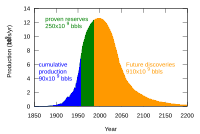
Photo from wikipedia
Wood export from a watershed is a function of peak annual discharge, but one hydrologic relationship alone does not fully explain observed variability. Consideration of physical processes that influence the… Click to show full abstract
Wood export from a watershed is a function of peak annual discharge, but one hydrologic relationship alone does not fully explain observed variability. Consideration of physical processes that influence the amount of wood available for transport is needed. However, wood recruitment, storage, mobilization, breakage, and transport rates and processes remain difficult to quantify. A theoretical wood transport equation focused on variations in discharge was the motivation for investigation into watershed-specific wood export rates. Herein, multiplicative coefficients categorized by water year type are developed, paired with the equation, and validated to provide a new method for prediction of wood export at the watershed scale. The coefficients are defined as representing a broad suite of watershed processes that encompass spatio-temporally variable scales. Two complementary datasets from the 1097 km2 mountainous North Yuba River, California watershed were used. Wood surveys above New Bullards Bar Reservoir yielded a wood availability estimate of 250 000–300 000 m3 along the channel network. Annual wood export into the reservoir was field-surveyed in 2010, 2012 and 2013, and estimated in seven years via remotely sensed images over the 30 year study period of water years 1985–2014. Empirical, watershed-scale wood export rates ranged from 0.3–5.6%. Comparison of predicted quantities using the new DVWP (discharge variations modified by watershed processes) wood export equation to observed wood export quantities resulted in an aggregate error rate of ±10%. When individual wood export quantities were compared, predicted to observed varied by 0.5–3.0 times. Total wood export of 59 000–71 000 m3 was estimated over the 30 year period, yielding a rate of 1.8 to 2.2 m3/year/km2. Wood export predictive capabilities at the watershed scale may help water resource and regulatory agencies plan for wood transfers to augment downstream ecosystems. Copyright © 2017 John Wiley & Sons, Ltd.
Journal Title: Earth Surface Processes and Landforms
Year Published: 2017
Link to full text (if available)
Share on Social Media: Sign Up to like & get
recommendations!